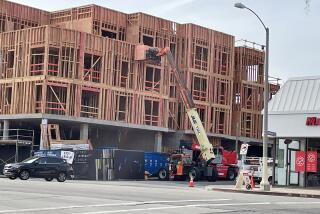Zoning Classes Redesigned for the Real World
- Share via
The impeccably dressed representatives of Royal Developers tried not to break a sweat as they were peppered with questions from a City Council skeptical of their multimillion-dollar proposal.
The problem wasn’t the asbestos removal, the disturbance of historic buildings or even the effects such a grand gentrification plan would have on a homeless shelter that sat square in the middle of the redevelopment zone.
It was parking--the nemesis of so many builders. Not enough spaces. So the fledgling firm was sent back to the drafting room.
Make that the classroom.
The fictitious company of four students from University High School in Irvine left the Urban Land Institute competition at Irvine City Hall last week with a newfound appreciation for the kind of headaches that the designers of the manicured city they live in must have endured.
“I had no idea how hard it is to make something that is nice and still affordable,” said senior Kevin Toyer, a member of Royal Developers.
That’s exactly the point.
This new breed of urban planning class engages thousands of students throughout Southern California; it is part of a nationwide push by land-use professionals to move beyond encouraging teenagers to dream and into equipping them with the practical skills to change the landscape.
Sim City-type exercises in which students draft pie-in-the-sky proposals are out. They’ve been replaced by intense courses that force students to do the things a real-life developer must do: Craft PowerPoint presentations and maps, study redevelopment laws and density bonus ordinances, and field letters from angry preservationists and low-income-housing advocates. And pull a workable plan together within budget.
“Students can do mapping and satellite positioning, then bring their proposals before a city council and be patted on the head and dismissed because there is no financial component,” said Paula Blasier, a project manger for UrbanPlan, the institute’s educational program. “We’re trying to let them know exactly how the system works,” she said.
The classes are another indication of how urban growth has moved to the front of the public discourse. Not long ago, educators viewed city planning and zoning as too obtuse to spend precious class time on. As the pressures of urbanization increase, they are finding that these kinds of programs are valuable because they help students understand how and why the physical structures of their communities are changing.
The institute’s curriculum is being used in more than a dozen high schools in the region, including nine in Orange County and four inner-city schools in Los Angeles.
Five other L.A.-area high schools have signed on with the Metropolitan Transportation Authority’s Transportation Academy, which offers students a hands-on opportunity to tackle regional transportation issues by teaching them engineering, architectural design and geographic mapping.
The success of these programs has prompted many schools to craft their own urban planning curricula.
At Orange Lutheran High School, students have been drafting plans for the closed El Toro Marine base and the oil fields that energy companies want to convert into housing on the border of Los Angeles and Orange counties.
“They are learning that if you own a piece of land, what you get to do with it is not entirely up to you,” said Susan Odle, chairwoman of the school’s social studies department.
Odle was in the stands as University and Anaheim high school students presented their plans to a panel of land-use professionals at last week’s competition in Irvine, hoping to get some ideas for her own classes.
The Irvine students gave elaborate presentations using all the props a developer would: meticulously drawn plans on easels, computer-generated images projected onto a big screen, and spreadsheets calculating revenue potential.
Their goal was to develop a workable redevelopment plan for an area called Summit Square in the fictional Midwest city of Amber Plains. The place is loosely based on a decaying historic neighborhood in Kansas City, Mo., where a development firm in the early 1980s restored the neighborhood while creating low-income affordable housing. The firm had to balance a mix of public and private funds with the political problems associated with gentrifying an urban neighborhood.
The students were given a thick packet of materials, including detailed descriptions of every historic building in the neighborhood, a breakdown of what construction costs would be for various types of facilities, and an environmental analysis warning that there may be a serious asbestos problem.
There were also letters from activists. The Heritage Society warned that it would file a lawsuit to stop the redevelopment, and residents of the homeless shelter demanded they not be displaced.
The students were given $40 million worth of bonds, grants, loans and other money to work with and were told they needed to develop a profitable plan that balanced preservation and political considerations with a mix of housing, commercial space and parks.
They had about a month to design their project. They then presented their plans to a group of local builders, planners and city officials who served as the Amber Plains City Council.
As the mock council grilled the students on why they placed a swimming pool next to the homeless shelter and why the library was infringing on green space, it all seemed familiar to University High parent Sam Sansone, who happens to be a developer.
“This is exactly what I have to go through when I give presentations,” he said during a recess. “They are asking some really intimidating questions.”
And that was exactly what Linda DeBoer, who taught the urban planning class at University High, wanted. “What I love about this is it is people actually in the business telling them what is and what isn’t,” DeBoer said.
The American Planning Assn. published an extensive report in 1999 that emphasized the importance of youth involvement in community planning and spotlighted examples of where it has worked across the country. Dozens of school districts have succeeded in getting students involved in local debates as seemingly mundane as general plan revisions, breaking down the process and showing them how it will affect their lives.
The association has given Rancho Cucamonga a national award for a particularly effective Internet-based program that exposes students to the planning process. The workshop first encourages students to study their community from a planning perspective, teaching them about how different land uses give character to the community. Then students work in teams to address neighborhood needs, and they are taught how the political process works and how they can get involved.
“Communities are recognizing that you have to involve the entire community at all age levels,” said Dan Coleman, principal planner for Rancho Cucamonga. “Especially here. We are young and we are growing.”
Blasier of the Urban Land Institute is leading a team creating the next generation of the program, which deals with some of the most vexing issues that face California communities today.
They will have to decide whether to include a “big box” warehouse-type store in their plan, knowing that it will bring jobs and tax revenue but also alter the character of neighborhoods and cause traffic headaches. They will have to worry about making enough profit to attract investors. And the students will record all of their moves on an extensive computer spreadsheet that calculates how each move will affect the return to their mock firm and to the city.
“They will have to balance the social challenges with economic consequences,” Blasier said. “They will see the tension.”
More to Read
Sign up for Essential California
The most important California stories and recommendations in your inbox every morning.
You may occasionally receive promotional content from the Los Angeles Times.











